Dho Yee Chung
Assistant Professor
Oakland University
Detroit is the epitome of the urban development crisis in the United States. Although it’s a city with a rich history in the automobile industry, it faces significant infrastructural challenges and urban decay. As the automobile industry decentralized from Detroit, the city’s booming metropolis experienced abandonment and neglect. Accordingly, the once-thriving industrial engine and the various signages that shaped Detroit’s urban landscape disappeared into its history. The symbolism in these signages is significant because it represents the visual artifacts of respective eras. Recognizing the importance of preserving this visual heritage, my project aims to create a digital archive that revitalizes Detroit’s vernacular visual language.
To ground a framework for symbolism in urban landscapes, this talk revisits Robert Venturi, Denise Scott Brown, and Steven Izenour’s seminal work, Learning from Las Vegas, which suggests a new paradigm in the urban landscape—communication over space. While Venturi and his colleagues focused on the context of Las Vegas in the 1960s, my project extends their ideas by bringing them into the present, where technological advancements continually redefine the human experience of urban spaces. With the advent of GPS platforms and self-driving cars with LiDAR technology based on real-time data, the traditional reliance on physical street signs has diminished. However, digital space suggests a new opportunity to transfer the lost vernacular language of the past into a digital archive accessible by any user.
My project seeks to bridge the gap between past and future by acknowledging forgotten history while enriching visual communication relating to Detroit’s urban landscape. This talk is expected to contribute to ongoing dialogues surrounding the intersection of technology, urban development, and visual communication, ensuring that the city’s rich heritage remains an integral part of its future trajectory.
This design research is presented at Design Incubation Colloquium 10.3: Tenth Anniversary, St. John’s University (Hybrid) on Friday, June 7, 2024.

